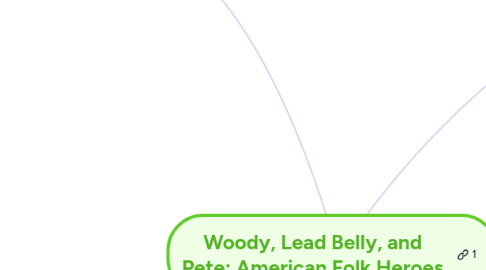
1. Singer Songwriter Tradition
1.1. Guitars became prominent in 1890's. Sears catalog.
1.2. Rural Tradition of Blues rather than an urban sound.
1.2.1. Guitars travelled easy
1.3. Crafting lyrics
1.3.1. Navigating away from Brill Building assembly-line songwriting tradition.
1.3.2. Lyrics contain veiled meanings/references
1.4. traditions befoe the singer songwriters
1.4.1. textile mill country songs
1.4.2. Industrial workers
1.4.3. "zipper songs"
1.4.4. Union songs
2. Backgrounds/ Legacies/ Influence
2.1. Disparate backgrounds
2.1.1. Lead Belly:
2.1.1.1. Louisiana
2.1.1.2. Son of share cropper
2.1.1.3. African American
2.1.1.4. died young
2.1.1.5. Fantastic suits
2.1.2. Guthrie
2.1.2.1. Oklahoma
2.1.2.2. Poor: Dust bowl refugee
2.1.2.2.1. started out somewhat affluent but became poor
2.1.2.3. White
2.1.2.4. died young
2.1.2.5. First to wear "bluejeans" outside of a worker environment
2.1.3. Seeger:
2.1.3.1. New York
2.1.3.2. Upper class: Mayflower descendent
2.1.3.3. White
2.1.3.4. died 2014. kept their music alive throughout
2.1.3.4.1. torch carrier
2.1.3.4.2. influenced the next generation of activists/musicians
2.1.3.5. "appleseed"
2.1.3.5.1. sprouting movements, and songs
2.1.3.6. Casual attire
2.1.4. Brothers from different mothers. Same type of soul
2.2. Legacy
2.2.1. Individually revered
2.2.2. Putting the music/lyrics into the language of the times
2.2.3. music/lyrics that the people can understand
2.3. Influence
2.3.1. Dylan, Baez, Punk, Tom Morello, Springsteen, Jimmy Collier, N.W.A.
2.3.1.1. contemporary torch carriers
2.3.1.1.1. influenced by Pete seeger
2.3.1.2. Baez influenced by Pete in a concert in 1950
2.3.1.3. Modern Hip-Hop
2.3.2. Key to the story
2.4. New York 1940's
2.4.1. How do the three connect? How do they interact.
2.4.2. Will Geer Grandpa walton /Actor
2.4.2.1. organized a benefit/ Grapes of Wrath benefit
2.4.2.2. met Guthrie in LA
2.4.3. Lomax/ Lead Belly
2.4.3.1. also rocorded for Moses Asch
2.4.3.2. Lomax might of been the glue to having the three meet
2.4.4. Radio prevalent/ exposure
2.4.5. The almanac group
2.4.5.1. 1941
2.4.5.1.1. war protest songs
2.4.5.2. Woody and pete lived together
2.4.5.3. Greenwich Villiage
2.4.5.3.1. all lived there
2.4.5.4. almanac singers datebook
3. Protest Movements/ Art as Activism
3.1. The three as a unique/unlikely brotherhood that opened the door for art as activism.
3.2. Inspired important future musical activists/innovators
3.3. The three
3.3.1. Seeger: Blacklisted by McCarthy
3.3.1.1. right wing blacklist. robber baron mentality.
3.3.1.2. the potency of language. Art as activism
3.3.2. Guthrie: Labor rights and workers culture
3.3.3. Lead Belly: Social justice - Bourgeois Blues, Jim Crow Blues
3.4. Union song tradition as activism
3.4.1. The nature of
3.4.2. Robber baron period 1800
3.4.2.1. Pushing back against
3.4.2.2. enslavemant and getting out of enslavement
3.4.2.3. These songs were made in response to the robber barons
3.4.3. Lyrics contain veiled meaning/reference
3.4.4. "zipper songs"
3.4.4.1. Adding in lyrics to a shared and recognizable theme
3.4.4.2. Also could be used in social movements
3.4.4.3. Empowering/emboldening
3.4.4.3.1. suporting the movement and its goals
3.4.4.4. Impetus for the singer songwriter
3.4.5. People should allowed to be free aside from their socio economic level.
3.5. Art as a weapon.
3.5.1. the potential to change sociaty
3.5.1.1. all the people matter not just the rich
3.6. Southern Prison system
3.6.1. Harsh realities of the agrarian south
3.7. Abstract art
3.7.1. Jackson Pollock

